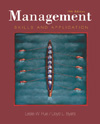 |  Management: Skills and Application, 10/e Leslie W Rue,
Georgia State University - Emeritus
Lloyd L Byars,
Georgia Institute of Technology
Operations Control
Chapter Summary1. Understand the basic requirements for controlling operating costs. The first requirement for controlling costs is to understand the organization's accounting and budgeting system. Once the budgets have been put into effect, they must be carefully monitored for any unexpected cost variances. Any cost variances detected must then be analyzed to determine the cause.
2. Define quality from the perspective of an operations manager. The operations manager's primary concern is that the product or service specifications be achieved. For the operations manager, quality is determined in relation to the specifications or standards set in the design stages.
3. List the eight common dimensions of design quality. The eight common dimensions of design quality are performance, features, reliability, durability, serviceability, response, aesthetics, and reputation.
4. Explain the concept of quality assurance. Quality assurance refers to the idea of "building in" quality as opposed to "inspecting it in."
5. Explain the concept of total quality management (TQM). Total quality management is a management philosophy that emphasizes managing the entire organization so that it excels in all dimensions of products and services that are important to the customer. In essence, TQM is an organizationwide emphasis on quality as defined by the customer.
6. Define continuous improvement and kaizen. Continuous improvement refers to an ongoing effort to make improvements in every part of the organization relative to all of its products and services. Kaizen is a philosophy for improvement that originated in Japan and that literally means "good change." Kaizen is basically a system of taking small steps to improve the workplace.
7. Describe ISO 9000, ISO 14000, and the zero-defects approach to quality. ISO 9000 is a series of quality standards established in 1987 by the International Organization for Standardization (ISO). ISO 9000 focuses on the design and operations processes and not on the end product or service. ISO 9000 requires extensive documentation in order to demonstrate the consistency and reliability of the processes being used. The ISO 14000 series was developed to control the impact of an organization's activities and outputs on the environment. A zero-defects program attempts to create a positive attitude toward the prevention of low quality.
8. Identify and define the two major types of quality control. The two major types of quality control are product quality control and process control. Product quality control is used when the quality is being evaluated with respect to a batch of products or services that already exist, such as incoming raw materials or finished goods. Under process control, machines or processes are periodically checked to detect significant changes in the quality produced by the process.
9. Recount the major reasons for carrying inventories. Inventories add flexibility to the operating system and allowing the organization to do the following:- Purchase, produce, and ship in economic lot sizes rather than in small jobs.
- Produce on a smooth, continuous basis even if the demand for the finished product or raw material fluctuates.
- Prevent major problems when forecasts of demand are in error or when unforeseen slowdowns or stoppages in supply or production occur.
10. Explain the concept of just-in-time (JIT) inventory. JIT is a philosophy for scheduling so that the right items arrive and leave at the right time. The basic idea under JIT is to have materials arrive just as they are needed.
11. Describe the ABC classification system for managing inventories. The ABC classification system is a method of managing inventories based on the total value of their usage per unit of time. In many organizations, a small number of products, group A, accounts for the greater dollar value of the inventory; the next group of items, group B, accounts for a moderate amount of the inventory value; and group C accounts for a small amount of the inventory value. The purpose of grouping items in this way is to establish appropriate control over each item. Generally, the items in group A are monitored closely; the items in group B are monitored with some care; and the items in group C are checked only occasionally.
12. Summarize the economic order quantity (EOQ) concept. When determining the optimal number of units to order, the ordering costs must be balanced against the cost of carrying the inventory. Ordering costs include such things as the cost of preparing the order, shipping costs, and setup costs. Carrying costs include storage costs, insurance, taxes, obsolescence, and the opportunity costs of the money invested in the inventory. The smaller the number of units ordered, the lower the carrying costs (because the average inventory held is smaller) but the higher the ordering costs (because more orders must be placed). The optimal number of units to order, referred to as the economic order quantity (EOQ), is determined by the point where ordering costs equal carrying costs, or where total cost (ordering costs plus carrying costs) is at a minimum.
13. Describe the basic purposes of material requirements planning (MRP). Material requirements planning is a special type of inventory system in which the needed amount of each component of a product is figured on the basis of the amount of the final product to be produced. When each component is needed depends on when the final assembly is needed and the lead time required to incorporate the component into the assembly. The purpose of MRP is to get the right materials to the right places at the right times. |
|



 2003 McGraw-Hill Higher Education
2003 McGraw-Hill Higher Education